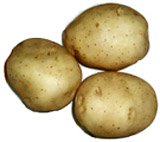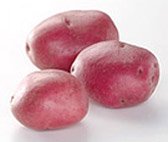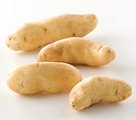Potato nutrition facts
Potato is a starchy root vegetable of Central American origin. This humble tuber is one of the most widely grown root crops and one of the cheapest staple food ingredients consumed all over the world.
Botanically, it belongs to perennial subspecies of Solanum tuberosum in the Solanaceae family.
 |
 |
| Potatoes-cream skin type. | Ida rose potatoes. Photo courtesy: The Idaho Commission. |
Potato plant grows about 12 to 18 inches in height and bears many tubers underground. The tubers usually have round to oval to oblong shapes but vary widely in size. Internally, its flesh features cream-white, rose red, or russet color depending upon the variety with a moist, crunchy texture and once baked, becomes soft and has a unique buttery "potato" flavor.
Some of the popular cultivars are:-

|
| Russian banana variety. |
White/yellow skin and flesh - Yukan gold, Yellow finn, Russian banana, Milva.
Red skin and flesh - Ida rose, Norland, Cal red, French fingerling.
Russet skin and flesh -Russet burbank, Ranger russet, Utamilla russet.
Health benefits of Potatoes
Potatoes are one of the finest sources of starch, vitamins, minerals, and dietary fiber. 100 g provides 77 calories. They carry little fat (just 0.1 g per 100 g) and no cholesterol.
They are excellent natural sources of both soluble and insoluble fiber. The dietary fiber in them increases the bulk of the bowel motions. Thus, it helps prevent constipation, decrease absorption of dietary cholesterol, and thereby, lower plasma LDL cholesterol. Additionally, its rich fiber content also helps protect from colon polyps and cancer.
The fiber content aids in the slow digestion of starch and absorption of simple sugars in the gut. It thus helps in keeping blood sugar levels within the normal range and avoids wide fluctuations. For the same reason, the potato is considered a reliable source of carbohydrates even in people with diabetes.
The tubers are one of the richest sources of the B-complex group of vitamins such as pyridoxine (vitamin B6), thiamin, niacin, pantothenic acid, and folates.
Fresh potato along with its skin is a good source of antioxidant vitamins, vitamin-C. 100 g of fresh tuber provides 11.4 mg or 20% of the daily required levels of this vitamin. Regular consumption of foods rich in vitamin C helps the human body develop resistance against infectious agents and scavenge harmful, pro-inflammatory free radicals.
They also contain adequate amounts of many essential minerals like Iron, manganese, magnesium, phosphorous, and copper.
Red fleshed potatoes carry more potassium (455 mg/100 g) than russet (417 mg/100g) and white flesh (407 mg/100g) varieties. Potassium counters the pressing effects of sodium and functions as a cardio-protective mineral.
Red and russet potatoes contain a good amount of vitamin A, and antioxidant flavonoids like carotenes and zeaxanthins.
Recent studies at Agricultural Research Service (by plant genetics scientist Roy Navarre) suggest that flavonoid antioxidant, quercetin present in potatoes has anti-cancer and cardio-protective properties.
| Principle | Nutrient Value | Percent of RDA |
|---|---|---|
| Energy | 77 Kcal | 4% |
| Carbohydrates | 17.49 g | 13% |
| Protein | 2.05 g | 4% |
| Total Fat | 0.10 g | 0.5% |
| Cholesterol | 0 mg | 0% |
| Dietary Fiber | 2.1 g | 5% |
| Vitamins | ||
| Folates | 15 μg | 4% |
| Niacin | 1.061 mg | 6% |
| Pantothenic acid | 0.279 mg | 6% |
| Pyridoxine | 0.298 mg | 23% |
| Riboflavin | 0.032 mg | 2.5% |
| Thiamin | 0.081 mg | 7% |
| Vitamin A | 2 IU | <1% |
| Vitamin C | 19.7 mg | 33% |
| Vitamin K | 2 mcg | 2% |
| Electrolytes | ||
| Sodium | 6 mg | 0.4% |
| Potassium | 425 mg | 9% |
| Minerals | ||
| Calcium | 12 mg | 1% |
| Iron | 0.81 mg | 10% |
| Magnesium | 23 mg | 6% |
| Manganese | 0.141mg | 6% |
| Phosphorus | 57 mg | 8% |
| Zinc | 0.30 mg | 3% |
| Phyto-nutrients | ||
| Carotene-ß | 4 μg | -- |
| Crypto-xanthin-ß | 0 μg | -- |
| Lutein-zeaxanthin | 21 μg | -- |
Selection and storage
Fresh vegetables can be readily available in groceries everywhere. Look for tubers that feature firmly in texture and have a smooth waxy surface. They normally have numerous "eyes" on their surface. Avoid those that feature soft in hand, and have a slumpy appearance, with cuts, patches, and bruises.
Often, you may come across greenish discoloration with sprouts over their surface. Do not buy them since this discoloration is an indication of old stock and a sign of the formation of toxic alkaloid, solanine.
At home, store them in a cold, dry, and dark place. Exposure to sunlight and excess moisture will cause potatoes to sprout and produce toxic solanine alkaloids.
Do not keep potatoes in the home refrigerator since they sustain chilling injury and develop discoloration and soft spots soon after being taken out of the fridge.
Preparation and serving methods
Being root vegetables, they are often subjected to infestation, and therefore, should be washed thoroughly before use in cooking. Fresh, cleaned tubers can be enjoyed with skin to get the benefits of fiber and vitamins.
Potato employed in dishes in many ways:
Skin-on or peeled, whole or chopped, with or without seasonings.
Mashed: Here potatoes are boiled and peeled, and then mashed with an addition of milk, cream, and butter.
Whole baked, boiled, or steamed.
Fried in oil or chips.
Prepare delicious soup/chowder with leeks, corn, onion and seasoning with salt and pepper.
Cut into cubes and roasted; scalloped, diced, or sliced and fried.
Grated and prepared dumplings, and pancakes.
Safety profile
Potatoes may contain toxic alkaloids, solanine, and chaconine. These alkaloids present in the greatest concentrations just underneath the skin and may increase proportionately with age.
Sunlight also causes green discoloration and thus displays areas of the tuber that may have more toxins. However, this does not provide a definitive clue as greening and solanine accumulation can occur independently of each other.
Some varieties may contain greater solanine alkaloid concentrations than others. Cooking at high temperatures (over 170 °C) somewhat destroys these toxic substances.
Solanine alkaloids, when consumed in larger amounts may cause a headache, weakness, muscle cramps and, in severe cases may cause loss of consciousness and coma. (Medical disclaimer).
≺≺-Back to Vegetables from Potato nutrition. Visit here for an impressive list of vegetables with complete illustrations of their nutrition facts and health benefits.
≺≺-Back to Home page.
Further reading:
University of Illinois Extension Solanum tuberosum.